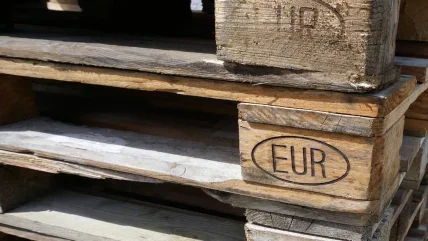
Summary
¦ Timber prices have fallen back slightly but remain an issue.
¦ Severe December weather created difficulties for pallet manufacturers.
¦ Four bank holidays in the spring should boost fencing demand for the domestic fencing.
¦ Agricultural fencing has good prospects.
The severe winter weather has provided its challenges for the fencing and pallet sectors alike.
Cutting frozen wood is never easy. One pallet manufacturer told TTJ that it boosted its labour force during the worst of the bad weather to try to keep output up, but still cut less.
Another said machinery iced up, transport movements were disrupted and customers were putting on pressure for deliveries. “We’re all going to lose a lot of money due to the weather,” said the contact. “It’s a very difficult balance between keeping the customer satisfied and operating safely.”
But at least pallet manufacturers have seen an easing off in raw wood prices – the massive increases seen in the first three quarters of 2010 relaxed in the autumn.
“Some pallet people are forecasting that the 2007-08 price scenario will happen again, with rapid price escalation being followed by prices falling rapidly,” said the contact. “I can’t see the prices falling because I can’t see where all the imports are coming from.”
A heady combination of raw material price inflation and continuing weak demand is not what the pallet sector wants to see more of this year and it would undoubtedly make some companies vulnerable to cash flow problems.
Price and cost rises
Another pallet manufacturer described prices as stable, after falling 2% in the final quarter of 2010. At the start of last year he was paying £105-145/m³ for home-grown/imported timber and sourcing 7,000m³ a month.
But, he said, rising steel, diesel and energy prices were probably more concerning at the moment and could cause nasty margin surprises.
Another manufacturer thought prices would firm up in 2011, especially when the spring fencing season kicks in. “Customers are aware that timber prices have fallen back a bit, but they have to be made aware that it’s a temporary blip and any downward move will be shortlived.”
He described supply as a bit tight, as sawmills have struggled to maintain output in the icy weather.
Home-grown timber remained the prevalent supply source in 2010, but more Baltic wood was reported later in the year. The problems of log extraction and cutting frozen logs may hold back these imports during the winter months.
Demand forecasts
On the demand side there’s a reasonable degree of optimism despite the important building products sector – a bell-wether of the pallet sector – seemingly headed for a tricky year. Pallet manufacturer comments range from demand being “fairly OK” to “optimism”.
One was confident of a “reasonably strong year”, with reports of several of its customers growing.
Concern is starting to rise that wood’s pre-eminence as the leading material for making pallets is being increasingly challenged by plastic.
In Europe, IKEA is replacing wooden pallets with a plastic ledge product combined with corrugated paper pallets, while pharmaceuticals firm Pfizer is switching to plastic pallets for transporting empty medicine bottles after having to recall 388,000 bottles of its Lipitor tablets because, it says, pallets made of wood preserved with the chemical 2, 4, 6-tribromonophenol caused an odour on them.





